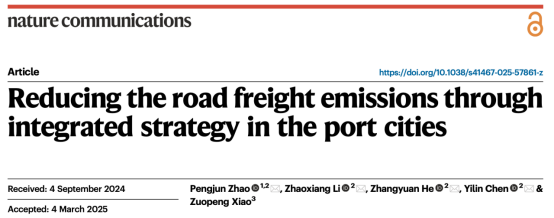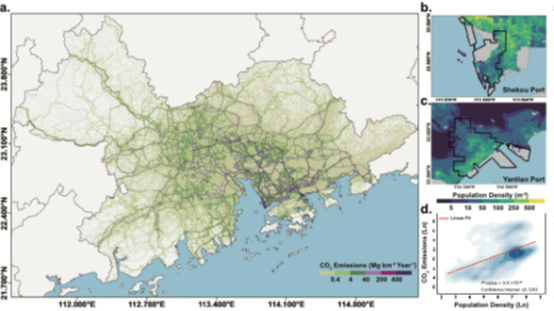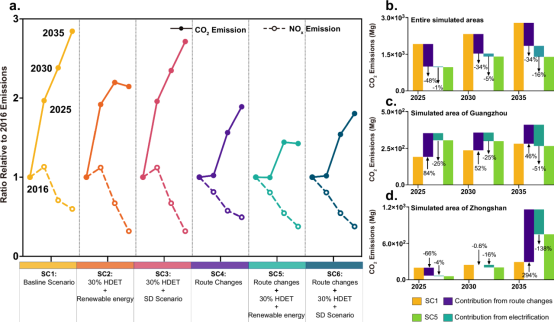Column Introduction
The "Urban Planning Academia" column periodically features the latest research achievements from various research directions of the School of Urban Planning and Design at Peking University, keeping the audience informed about cutting-edge academic developments.

Globally, 40% of the population resides in coastal areas within 100 kilometers of shorelines, while 50% of the world’s wealth is concentrated in port cities. As critical hubs in global supply chains, port cities face challenges of transportation-related carbon emissions and pollution. Building green, low-carbon port cities and transportation systems, and exploring emission reduction pathways for port city logistics, have become pivotal scientific and policy priorities for sustainable development.
Professor Zhao Pengjun’s research team at Peking University has developed an innovative Integrated Future Emissions Prediction Framework for Port Cities (IFEPP). This framework integrates trajectory-based microscopic vehicle emission models, traffic flow simulations, and statistical fleet models, comprehensively accounting for dynamic freight demand, fleet electrification/upgrading, and road network evolution. Leveraging 1.2 billion GPS trajectory records of heavy-duty trucks (HDTs) in Shenzhen—the world’s fourth-largest port city—the study evaluates the synergistic effects of fleet electrification and regional road network development (2016-2035) on CO2 and air pollutant emissions in the Pearl River Delta region. This big data-driven approach provides a unique scientific foundation for high-resolution emissions modeling and traffic simulations.
The IFEPP framework addresses the complexities of integrating multidimensional factors through robust data processing, model integration, and dynamic adaptability. It harmonizes freight demand, fleet electrification, and road network dynamics to deliver high-resolution emission forecasts, identify key emission redistribution patterns, and guide actionable mitigation strategies for port cities and their hinterlands.
Key Findings
Emission Hotspots: Core port areas are major emission hotspots, contributing 12% and 13% of total CO2 and NOx emissions in the study area, respectively (Figure 1). Limited port infrastructure and urban road capacity force HDTs into densely populated zones, exacerbating traffic congestion and pollution. Uneven distribution of freight facilities further overlaps freight corridors with residential areas, amplifying local emissions and public health risks.

Figure 1: Spatial distribution of CO2 emissions from heavy-duty trucks in the Pearl River Delta region, Shenzhen, 2016.
Baseline Emission Trends: Under the IFEPP framework, the baseline scenario projects HDT numbers to surge from 19,000 (2016) to 66,000 (2035). Despite stricter emission standards (e.g., China VI), CO2 and CO emissions will grow at an annual rate of 5.7% due to fleet expansion.
Electrification Synergies:
Zero-Emission Grid Scenario: A 30% annual growth rate of heavy-duty electric trucks (HDETs) could peak CO2 emissions by 2033.
Sustainable Development Grid Scenario (47% renewables): HDET adoption reduces CO2 by 18.5% but fails to achieve peak emissions by 2035.
Road Network Optimization: Improved regional connectivity (e.g., Shenzhen-Zhongshan Link) suppresses CO2 growth to 89% (vs. 184% in baseline) by 2035 and reduces NOx by 11%. Emissions gradually shift southwestward, highlighting the spatial redistribution driven by infrastructure upgrades (Figure 2).

Figure 2: Emission reduction performance of regional road network connectivity improvements on HDT-derived CO2 and NOx.
Integrated Strategy: Combining fleet electrification with road network development delivers synergistic benefits (Figure 3). While HDETs under a zero-emission grid show decarbonization impacts post-2030, road network enhancements provide immediate emission suppression. The integrated approach reduces peak CO2 and NOx by 34% and 43%, respectively, ensuring long-term sustainability.

Figure 3: Emission trajectories under different HDT mitigation strategies (2016-2035).
The research findings, titled “Reducing the road freight emissions through integrated strategy in the port cities,” were published online in Nature Communications on March 15, 2025. Professor Zhao Pengjun from Peking University served as the first author and corresponding author. Co-corresponding authors include Master’s student Li Zhaoxiang, Dr. He Zhangyuan, and Assistant Professor Chen Yilin. This work was supported by the National Natural Science Foundation of China (Grant No. 41925003).
Paper Link:https://www.nature.com/articles/s41467-025-57861-z
Text and Images | Zhaoxiang Li, Zhangyuan He
Reviewed by | Pengjun Zhao